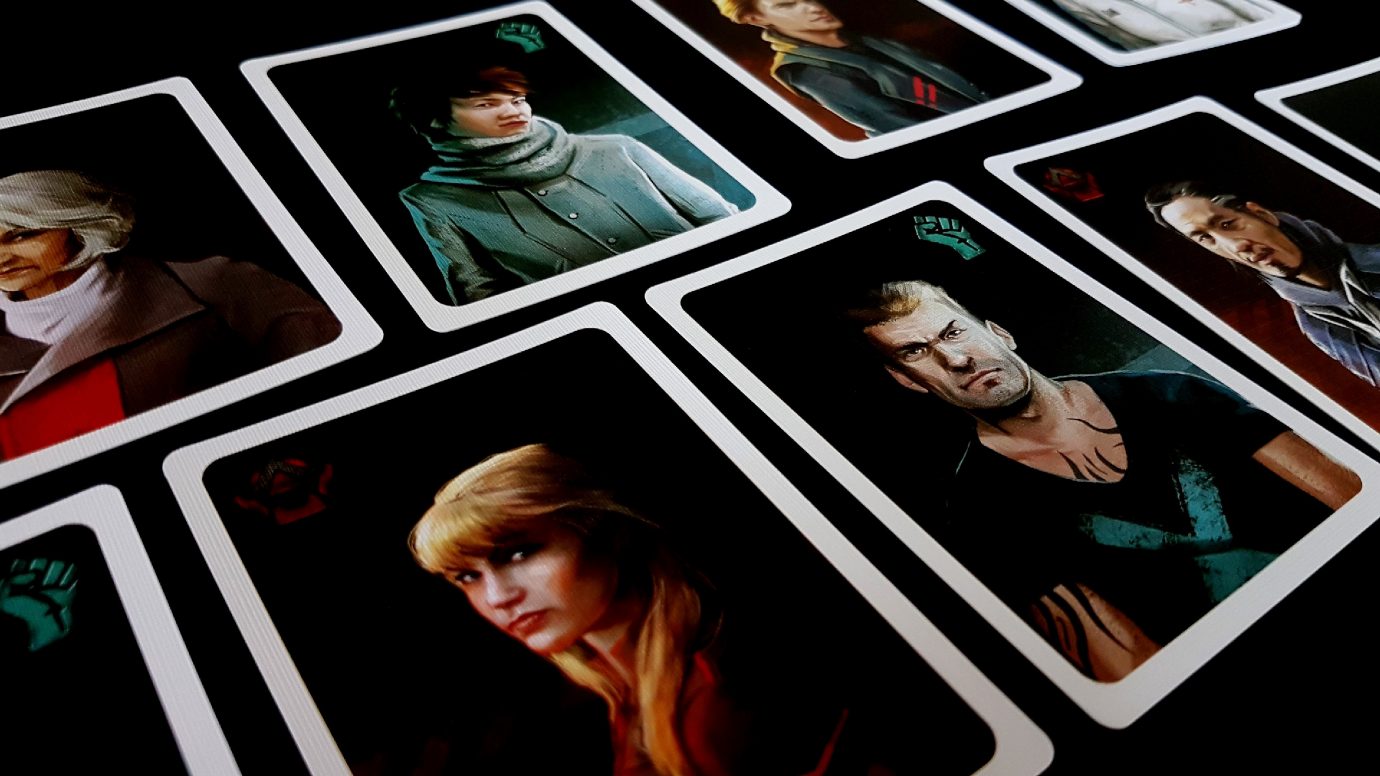| Game Details | |
|---|---|
| Name | The Resistance (2009) |
| Accessibility Report | Meeple Like Us |
| Complexity | Medium Light [1.59] |
| BGG Rank | 398 [7.21] |
| Player Count | 5-10 |
| Designer(s) | Don Eskridge |
| Buy it! | Amazon Link |
A few days ago (at the time of writing – many months ago at the time of publishing) I had the opportunity to drop into Dundee and Angus College to play games with a bunch of students on the HND in Computer Games course. D&A is where Mrs Meeple works and apparently this is just what they do all day – sit around playing board games, messing around with consoles, and eating cakes. She denies this vociferously, but all I can say is that every single time I’ve been in a classroom there with her students it’s just been a wildly self-indulgent games day. Every single time. How the other half live, eh? And she claims I have a cushy job. The bare-faced cheek of it.
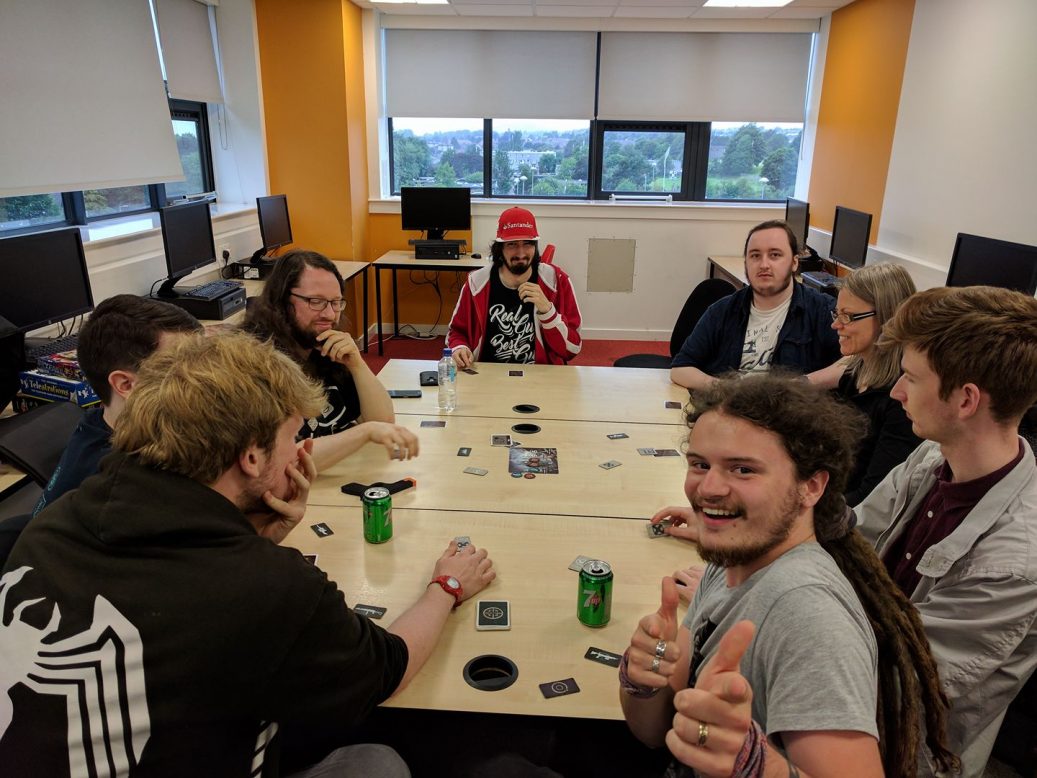
Dirty traitors, the lot of them.
The Resistance was one of the games we played a good few times in many different compositions and I was very happy that was the case. Being a grown up (sort of) with real world responsibilities, it’s often difficult to gather groups of other grown-ups with other real world responsibilities together in one place at one time. A group of five, which is the minimum required for the Resistance, is certainly possible. A group of twelve, which we had for one of the earlier games at D&A, is a logistical impossibility – an act of scheduling and organisation on a par with the D-Day landings. It’s just not going to happen in the regular course of events. As such, I’ve never really felt like we’ve had the best opportunity to really try out The Resistance at its best. It’s a game that is inherently dependent on the electricity its participants can contribute. We might have been able to hook the box up to a couple of AA batteries easily enough, but it would be unfair to judge it until we could plug it into the national grid and see it really shine.
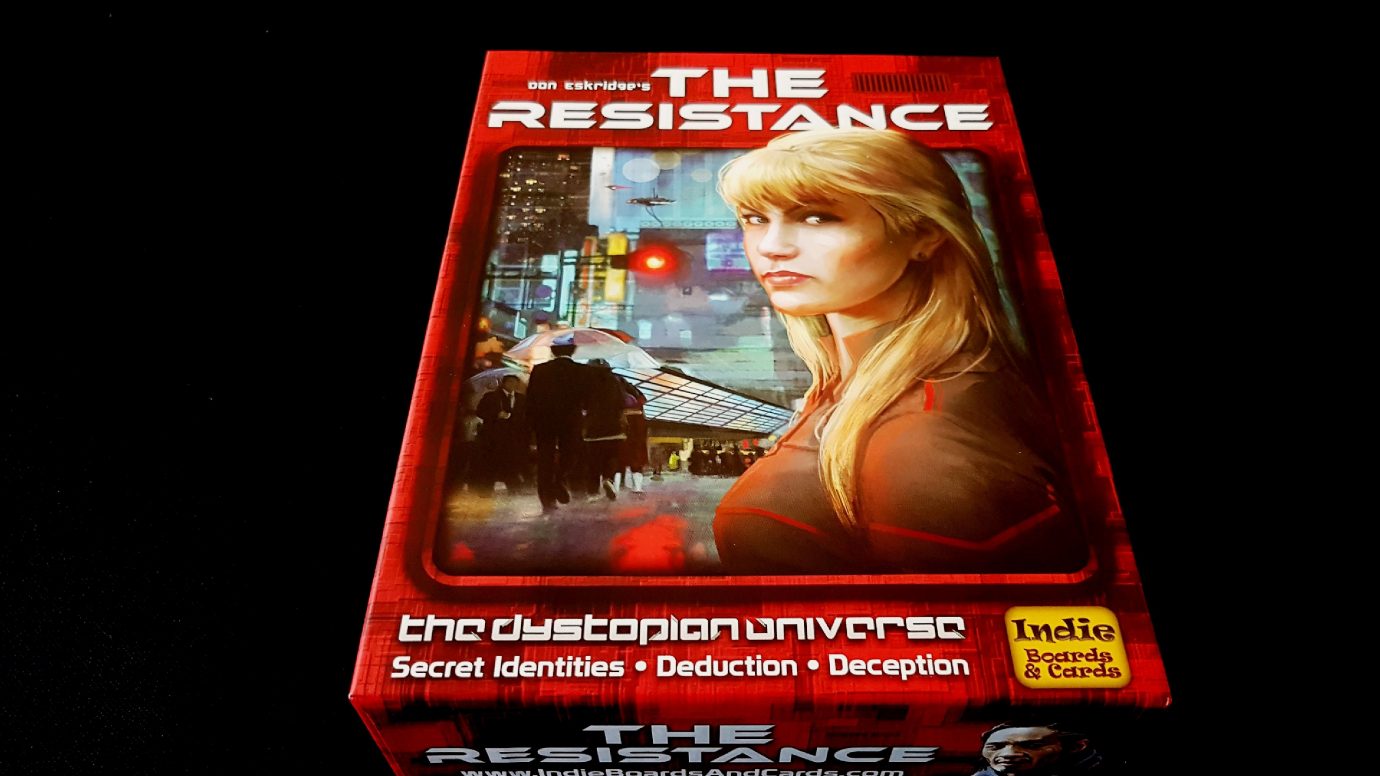
SHE’S A SPY
It’s weird really it’s taken me so long to actually properly play the Resistance properly. In its own way it’s one of the games that dragged me into this hobby in the first place. I’ve made no secret of the fact that Tabletop and Shut Up and Sit Down were my gateways to this cardboard nerdvana. I’d played Catan and Carcassonne in the past, but it was really the Resistance episode of Tabletop that made me seriously sit up and think ‘Wow, there really are other worlds than these’. I know it’s very fashionable to hate Tabletop nowadays, but man – the good episodes are genuinely inspirational. The Resistance session, in my view, is absolutely must see. It shows exactly why tabletop gaming continues to astound me with the sheer baseline innovation to be found in an unassuming cardboard box.
And unassuming it most certainly is – opening the box of the Resistance is like delving into a disappointing Christmas present. There are a dribble of cards, a handful of markers, and a triad of flimsy double-sided paper ‘boards’. One is compelled at this point to turn the box over, comically hoping for the real game to drop out onto the table. Don’t despair though – this is the game and it is absolutely everything you need to have a tremendously good time despite being deeply, intensely suspicious of the people you brought to the table. Paranoia has never been quite this much fun.
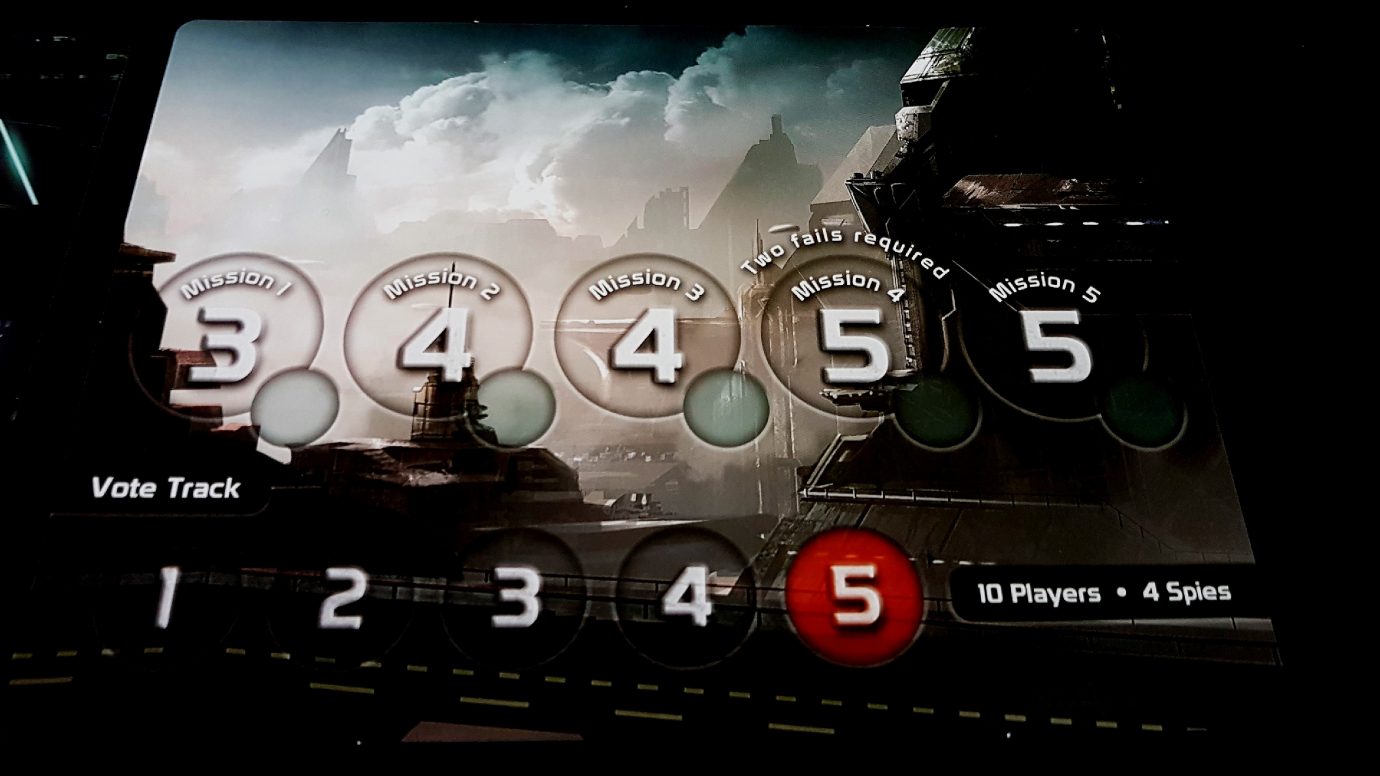
THEY’RE SPIES TOO
Here’s how it works – you and everyone at the table are members of The Resistance (boom, title drop) – a brave collective of freedom fighters (or cowardly cell of terrorists, depending on your political bent). You’re engaged in acts of incivil disobedience against the brutally corrupt government that has taken root across the world. You’re standing up for the many against the few, the poor against the rich, and the weak against the strong. Coup, which we discussed elsewhere on this blog, is set in the same universe. Coup allows you to engage in the politicking and maneuvering of a billionaire plutocrat where the great game of influence is waged in secret rooms with quiet conversations. The Resistance puts you on the other end of the power curve – the disaffected who have little access to power, but considerable access to weaponry and the unshakeable will to use it.
The problem is – the Resistance is not a unified force. It’s small, underfunded, and infiltrated at all levels by loyal agents of the authorities. The spies of the government are buried like little ticks into the structures of rebellion, and even the most influential agent can be working against the will of the movement. Oh no.

EVEN THE LOYAL ONES ARE SPIES. WHY ISN’T ANYONE LISTENING TO ME
At the beginning of play, each of you get dealt out a card representing which resistance member you are. These are marked either with the clenched fist of defiance or the nationalist brand of authority. This role is yours, and it is completely secret. Nobody but you knows your loyalty, and nobody ever gets to see your card. You can tell people you’re loyal, but well – that’s exactly what a spy would say, right?
Once the cards are dealt, everyone closes their eyes.
The current leader of the Resistance then says ‘Spies, open your eyes and make contact with your colleagues’.
They do – depending on how many players there will be between two and four spies. They know who they are. They know who each other is. Nobody else knows anything. Their eyes meet, their heads nod imperceptibly. Contact made.
‘Spies, close your eyes. Everyone keep them closed.’
A few second pass while tell-tale signs like pupil dilation and beads of sweat are given a chance to dissipate.
‘Everyone, open your eyes’, says the leader. Everyone does, and everyone is instantly wary of every single person they until very recently considered a friend. Lives are on the line here – friendships come and go, but this is the one chance everyone has to bring down the government, or preserve it for another day.

At least one spy approved. EVERYONE ON THE TEAM IS A SPY.
Everyone is also given a pair of chits that represent their authority to ‘approve’ or ‘reject’ the team for upcoming missions. The Resistance isn’t actually a board game really – it’s a negotiation game that only uses the board for tracking score. Leadership of the movement rotates around the table, and the leader at any stage of the game can propose a team to go on a mission by distributing weapon tokens. Once the team has been arranged everyone votes on whether to approve. If the majority of table approves a mission, the mission is set and the agents set off to accomplish, or sabotage, the task they have been given. If the table rejects the mission, leadership rotates to the next agent and the ominous vote tracker is moved on one place. When this reaches the end, the spies win.
Nobody ever has to leave the table – this isn’t a LARP. Instead, all team members get dealt out a pair of cards. One of these says ‘success’, and loyal agents must always play their success card. The other card says ‘fail’, and spies can choose to play either card during the mission.

I KNEW IT
Once the cards are collected up from the team members they’re turned over to reveal the outcome of the mission. On most missions, except the fourth, a single fail is enough to tank it. On the fourth, two fails are required. The spies are looking to sabotage three missions before the resistance successfully complete three. And that is it – at the end, spies reveal themselves and everyone celebrates as appropriate, or throws themselves on their swords as honour demands.
The Resistance, when explained, sounds like it has all the substance of a spider-web in a tumble-drier. And yet, AND YET, the minutes you play the Resistance can be genuinely stressful in the best possible way. Familiarity with the rogue’s gallery of potential traitors around the table gives everything a frisson of meaning. Unfamiliarity injects every single word and gesture with the accelerant of paranoia. The balance of power and trust shifts constantly, and logic is only a partial shield against the cunning arrayed against the loyal members of the table. What’s more important is stridency and the throwing of copious amounts of shade at those you suspect of misdeeds. If you’re on the side of the government, nothing is more key to success than making sure that suspicion never settles on too many of you. You need to behave like someone that just unloaded a weaponised fart in a crowded room – mingle a bit so nobody can identify you as the source of the unfolding horror. ‘Sure, that mission was a fail but I’ve been on two missions before that and both were successes. You know who’s new to this mission? YOU. Isn’t it telling that the first thing that happens is it fails, and the first thing you do after that is immediately blame someone that’s proven their loyalty?’. It’s not necessary that people believe you – just that they disbelieve everyone else more.
The spies succeed, as a team, if three missions are sabotaged. As such, if you can ensure that state of affairs by throwing a colleague under the bus then absolutely that’s what you should do. Sure, they might end up buried in a shallow grave with a bullet in the back of their head but the cruel and amoral billionaires you serve will have one less thing to worry about when they go to sleep. As such, it’s not even as simple as the loyalists rooting out the spies. Sometimes those spies are part of the mob because as long as they’re trusted they’ll be taken along on missions. The missions are guaranteed to succeed if the spies aren’t present, so it’s important to make sure that someone can prevent it. As such, it’s sometimes as much in your best interest as it is in the loyalists to focus the beam narrowly on a fellow spy that’s already been compromised. They in turn will be trying to not only make themselves look like they’re trying to look innocent, but also trying to rope a loyalist into their net of lies and half-truths. If they’re going to drown, they’re going to do all they can to tangle the loyalists up so they sink to the bottom with them.
But the thing is, this would be an easy job for the agents if they knew who each other was – but they don’t. It’s only the spies that work as a team. All the other agents are alone in a complex matrix of ever shifting loyalty. It’s like being a Capo in the last few seasons of the Sopranos where the only thing standing between you and ‘retirement’ is your ability to read imminent betrayal into the open smile of a friend. The mathematics of deception almost never work in your favour, and even if you are sure you’ve identified a spy or two you still need to get the table to believe you. You might have the cold, hard mathematics of probability to back you up but you’ll likely find that even rock-solid arguments ring hollow when even your allegiance cannot be guaranteed.
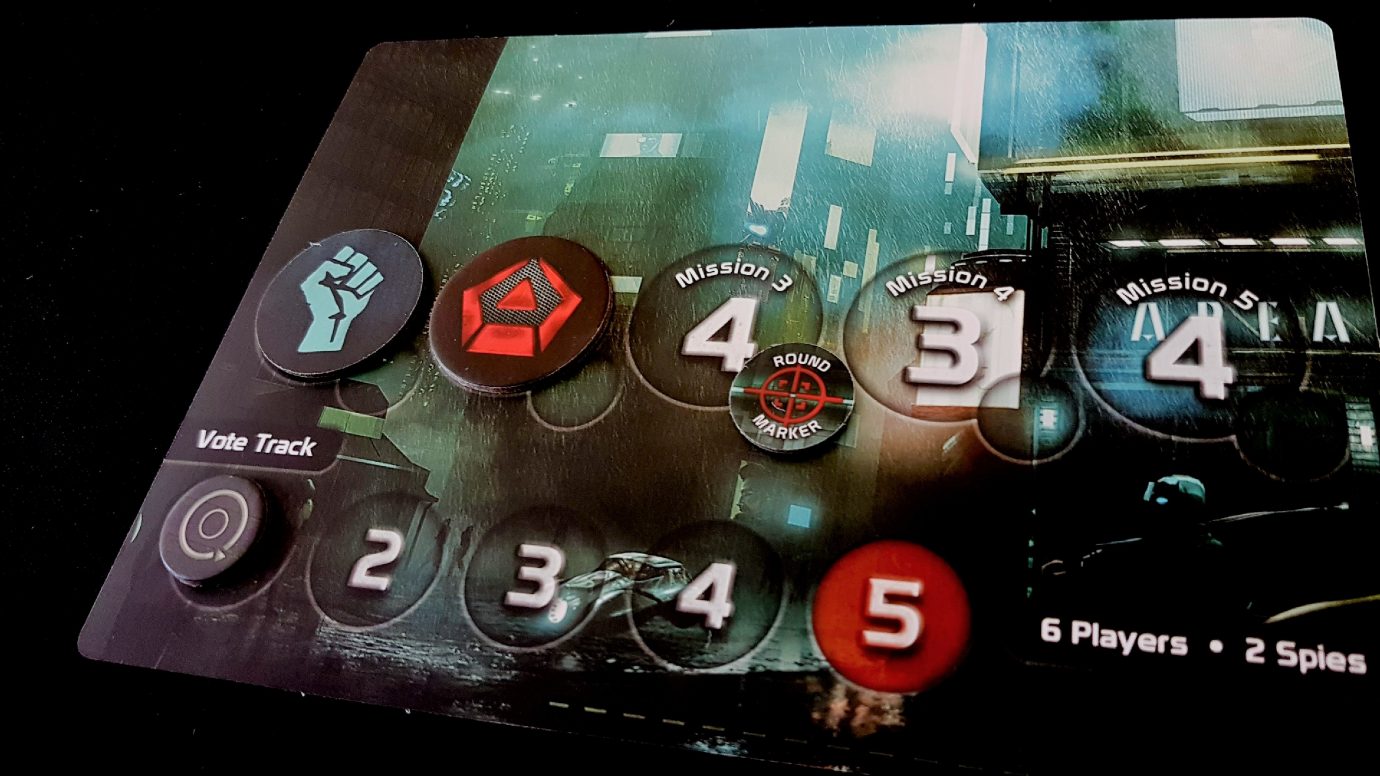
We’re doomed
Here’s an example of a game we played at the college. I had picked out a team of four people. Myself, Mrs Meeple, and two others from the table. We did the voting, and the mission was narrowly approved. We dealt out the mission cards. We gathered up the discards. We collected up the others. And I dealt them out, one at a time. Success. Success. Fail. And… fail.
Oh. My.
Now, this is about as good a result for the Resistance as you can hope for. There were three spies around the table, and we knew that at least two of them were in this mission. That’s great, but it’s even better than that. Two spies on a mission is a bad idea except for the fourth – you usually only need a single fail to tank a mission, but the spies have no way to communicate secretly after the initial reveal. So, you put two spies on a mission and neither knows whether their colleague is going to play a succeed or a fail. It’s a prisoner’s dilemma – if neither fail the mission, it succeeds and both spies lose out. If only one of them play a succeed, then they both get the optimal outcome – a mission failure and no unnecessary disclosure. If both play a fail then both lose out. MmMmMmmMmmm. That’s so good. IT’S SO GOOD YOU GUYS.
But there’s more! Because the leader would absolutely not arrange a mission like that if they were disloyal. I mean, I suppose they could if they wanted to take the risk but the risk is intense. So the result here, I argued forcefully, conclusively proved I was loyal because no spy would send that mission out into the wild. It would be utter folly. ‘This is great!’, I said,’ We know that at least two of the other three are spies! We’ve won this!’
The table mulled this over until someone else said, ‘Yeah, but you would say that, wouldn’t you?’
Could I get the table as a whole to believe my immaculate chain of logic? Could I buggery, and the more I argued for it the more guilty I appeared.
The next mission, leadership moved to another player. He instantly recused himself from the mission and sent Mrs Meeple instead. ‘THEY’RE THE SPIES’, I yelled. ‘GOD DAMN IT THEY’RE THE SPIES EVERYONE LISTEN NO, STOP’. Of course they were the spies because no-way is the spy going to send two of them on a mission again. Only one spy on a mission.
Could I get the table to believe me? Could I buggery.
Imagine just how invested you might get in this kind of thing when you’re the only rational voice in a mob of half-truths and wild accusations. Just imagine when you’ve shown yourself a paragon of purity and yet there’s still enough distrust around the table to make you seem dodgy. It’s enough to drive someone to paranoid rants of increasing stridency – you know, just the kind of thing that dissuades people purely because of the tone as opposed to the content. You either die a hero, or live long enough to see yourself become the villain.

Spies like us
There was a scenario in another game where I managed to reveal that I was a spy because I wasn’t aware of information I would have had otherwise (this involved the use of an expansion module, so I won’t go into the specifics). Someone else was revealed as absolutely loyal simply because of my status being outed. Our relative allegiances could have been reversed if I had the information I should have had. So, what did I do? I pretended that I hadn’t quite understood the rules. ‘Oh, I didn’t… well, look – all I’m saying is that I might not have quite picked up on that I should have done something during the setup. I was supposed to open my eyes? Yeah, I didn’t open my eyes during that phase. As such, I might through my own confusion not have access to information that should be available’.
And that was true, but the reason it was true was because I wasn’t the person I was pretending to be. The other player, for whatever reason, opted to remain quiet – perhaps because he was engaged in another argument with someone else, or perhaps because he was waiting for my obvious bluff to fail so he shone all the brighter in the follow-up spotlight. I mean, even I wasn’t convinced. But the other spies… well, they went to work. They found that crack of doubt and started crowbarring it open. A few minutes later, I found people saying ‘Well, we know for sure Michael is loyal so…’
Man, this is a great game. A wonderful exemplar for just how electric the experience of analog play can be. The kind of thing you introduce to someone still caught up in the mindset of Monopoly, only for them to emerge from the game with sweat drenching their shirts and a dazed expression on their face. You look at them. They look at you. Then they say ‘Can we play that again?’
All of this said, The Resistance suffers from the One Night Ultimate Werewolf problem in that not everyone gets to have as much fun as everyone else. It’s fun to be a spy, and if you’re using the expansion it’s fun to get one of the more complex roles. It’s not a huge amount of fun to be a vanilla agent in the same way it’s not a huge amount of fun to be a vanilla villager. It’s a bigger problem here too because games of the Resistance last considerably longer than games of ONUW.
You’re very much at a disadvantage if you’re not comfortable in stridency in your accusations or bare-faced deceit in your defense. If you don’t have an important role and also don’t thrive in adversarial scenarios you might very well find yourself being mostly a spectator. More, if you’re not comfortable with being the centre of attention you might well find it thrust upon you regardless just because of the way the roles are dealt out.

I know that look. SHE’S A SPY.
If proceedings are dominated by a few loud voices, it can be very difficult to be heard and equally difficult to feel like you are actually one of the players. Those are issues that are tremendously common to this family of games, and to a certain extent you know this is likely to be the case when you sit down to a session. The Resistance absolutely excels in this genre, but you do need your group to be made up, at least in the majority, of a certain kind of personality. It’s not as simple as ‘this is a game for extroverts’, but rather ‘this is a game for people that can project disagreement outwards, rather than inwards’.
If you can engineer that though and get enough of those people together in one place at the same time you’ll certainly have an awful lot of fun with the Resistance. It has been expanded upon by later games, and endlessly remixed with reskins, revisions and expansions. This simple base box though has more than enough inside to warrant consideration for your game shelves and I’d certainly recommend you check it out.
